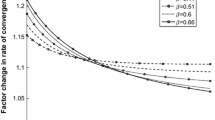Abstract
We formulate a two-country, two-good, two-factor endogenous growth model with learning by doing and intersectoral knowledge spillovers. Our model exhibits no transitional dynamics because of constant returns to capital, the existence of only one state variable for each country, and the factor price equalization theorem. By applying our model to the problem of aid and growth, we show that a permanent increase in untied aid raises the common growth rate if and only if the propensity to consume the capital-intensive good in the recipient country is larger than in the donor country.
Similar content being viewed by others
References
Acemoglu D, Ventura J (2002) The world income distribution. Q J Econ 117: 659–694
Bajona C, Kehoe TJ (2006) Demographics in dynamic Heckscher-Ohlin models: overlapping generations versus infinitely lived consumers. NBER working paper no. 12566
Baldwin RE (2008) The development and testing of Heckscher-Ohlin trade models: a review. MIT Press, Cambridge
Barro RJ, Sala-i-Martin X (1995) Economic growth. McGraw-Hill, New York
Bhagwati JN, Brecher RA, Hatta T (1983) The generalized theory of transfers and welfare: bilateral transfers in a multilateral world. Am Econ Rev 73: 606–618
Bond EW, Trask K, Wang P (2003) Factor accumulation and trade: dynamic comparative advantage with endogenous physical and human capital. Int Econ Rev 44: 1041–1060
Brakman S, Marrewijk Cv (1998) The economics of international transfers. Cambridge University Press, Cambridge
Brecher RA, Bhagwati JN (1982) Immizerizing transfers from abroad. J Int Econ 13: 353–364
Burnside C, Dollar D (2000) Aid, policies, and growth. Am Econ Rev 90: 847–868
Chao C-C, Yu ESH (1999) Foreign aid, the environment, and welfare. J Dev Econ 59: 553–564
Chatterjee S, Sakoulis G, Turnovsky SJ (2003) Unilateral capital transfers, public investment, and economic growth. Eur Econ Rev 47: 1077–1103
Chatterjee S, Turnovsky SJ (2007) Foreign aid and economic growth: the role of flexible labor supply. J Dev Econ 84: 507–533
Chen Z (1992) Long-run equilibria in a dynamic Heckscher-Ohlin model. Can J Econ 25: 923–943
Doi J, Nishimura K, Shimomura K (2007) A two-country model of international trade and endogenous growth: multiple balanced growth paths and stability. J Math Econ 43: 390–419
Drugeon J-P, Poulsen O, Venditti A (2003) On intersectoral allocations, factors substitutability and multiple long-run growth paths. Econ Theory 21: 175–183
Easterly W, Levine R, Roodman D (2004) Aid, policies, and growth: comment. Am Econ Rev 94: 774–780
Farmer REA, Lahiri A (2005) A two-country model of endogenous growth. Rev Econ Dyn 8: 68–88
Feenstra RC (1996) Trade and uneven growth. J Dev Econ 49: 229–256
Feenstra RC (2004) Advanced international trade: theory and evidence. Princeton University Press, Princeton
Grossman GM, Helpman E (1991) Innovation and growth in the global economy. MIT Press, Cambridge
Hansen H, Tarp F (2001) Aid and growth regressions. J Dev Econ 64: 547–570
Hu Y, Kemp MC, Shimomura K (2005) A factor endowment theory of endogenous growth and international trade. Rev Dev Econ 9: 467–481
Hu Y, Kemp MC, Shimomura K (2009) A two-country dynamic Heckscher-Ohlin model with physical and human capital accumulation. Econ Theory 41: 67–84
Keller W (2002) Trade and the transmission of technology. J Econ Growth 7: 5–24
Kemp MC, Kojima S (1985) Tied aid and the paradoxes of donor-enrichment and recipient-impoverishment. Int Econ Rev 26: 721–729
Lahiri S, Raimondos-Møller P, Wong K-y, Woodland AD (2002) Optimal foreign aid and tariffs. J Dev Econ 67: 79–99
Mountford A (1999) Trade dynamics and endogenous growth: an overlapping-generations analysis. Economica 66: 209–224
Mundell RA (1957) International trade and factor mobility. Am Econ Rev 47: 321–335
Naito T (2003) Revenue-neutral tariff reform and growth in a small open economy. J Dev Econ 71: 213–232
Naito T, Ohdoi R (2008) Dynamics of a two-sector endogenous growth model with intersectoral knowledge spillovers. Econ Theory 35: 599–605
Nishimura K, Shimomura K (2002) Trade and indeterminacy in a dynamic general equilibrium model. J Econ Theory 105: 244–260
Ohdoi R (2007) Productive government spending, patterns of specialization and economic growth in a small open economy. Jpn Econ Rev 58: 127–146
Ono Y, Shibata A (2005) Fiscal spending, relative-price dynamics, and welfare in a world economy. Rev Int Econ 13: 216–236
Ono Y, Shibata A (2010) Time patience and specialization patterns in the presence of asset trade. J Money Credit Bank 42: 93–112
Osang T, Pereira A (1996) Import tariffs and growth in a small open economy. J Public Econ 60: 45–71
Park J (2004) International and intersectoral R&D spillovers in the OECD and East Asian economies. Econ Inq 42: 739–757
Rajan RG, Subramanian A (2008) Aid and growth: what does the cross-country evidence really show?. Rev Econ Stat 90: 643–665
Rivera-Batiz LA, Romer PM (1991) Economic integration and endogenous growth. Q J Econ 106: 531–555
Romer PM (1986) Increasing returns and long-run growth. J Political Econ 94: 1002–1037
Segerstrom PS, Anant TCA, Dinopoulos E (1990) A Schumpeterian model of the product life cycle. Am Econ Rev 80: 1077–1091
Trefler D (1993) International factor price differences: Leontief was right!. J Political Econ 101: 961–987
Turnovsky SJ (2002) Knife-edge conditions and the macrodynamics of small open economies. Macroecon Dyn 6: 307–335
Wong K-y (1995) International trade in goods and factor mobility. MIT Press, Cambridge
Author information
Authors and Affiliations
Corresponding author
Rights and permissions
About this article
Cite this article
Naito, T., Ohdoi, R. A two-country model of trade and growth with intersectoral knowledge spillovers. J Econ 103, 39–58 (2011). https://doi.org/10.1007/s00712-010-0178-4
Received:
Accepted:
Published:
Issue Date:
DOI: https://doi.org/10.1007/s00712-010-0178-4
Keywords
- Endogenous growth
- Intersectoral knowledge spillovers
- Factor price equalization theorem
- Aid and growth
- Stolper–Samuelson theorem




